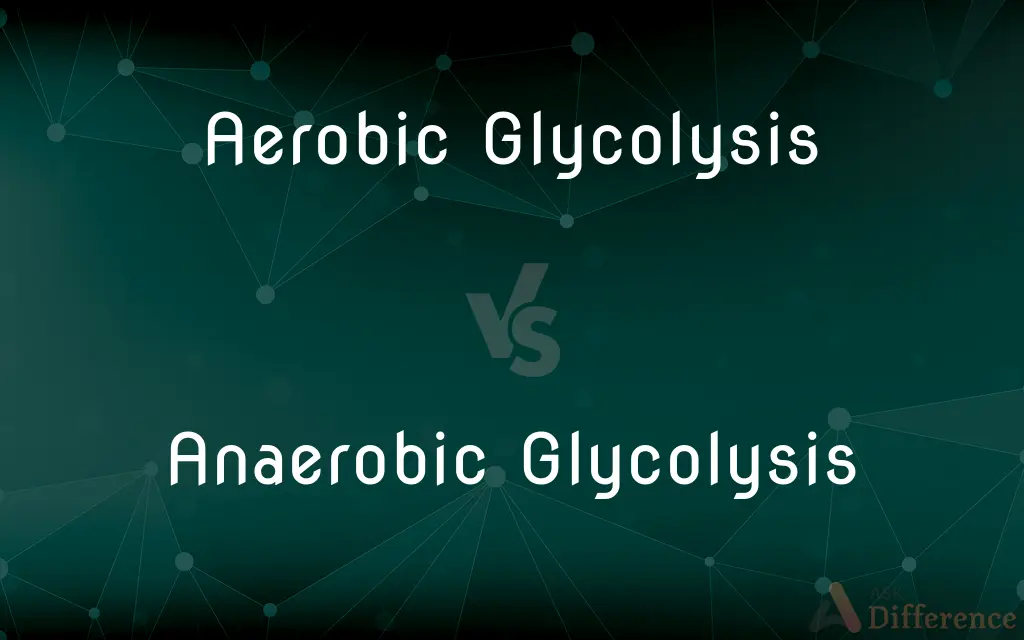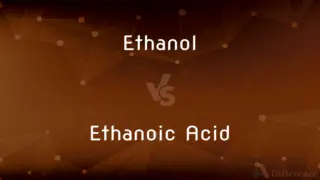Aerobic Glycolysis vs. Anaerobic Glycolysis — What's the Difference?
Edited by Tayyaba Rehman — By Fiza Rafique — Published on January 3, 2024
Aerobic glycolysis requires oxygen and produces more energy, while anaerobic glycolysis occurs without oxygen but generates less energy.

Difference Between Aerobic Glycolysis and Anaerobic Glycolysis
Table of Contents
ADVERTISEMENT
Key Differences
Aerobic glycolysis occurs in the presence of oxygen, efficiently producing energy. Anaerobic glycolysis functions without oxygen, yielding less ATP.
During aerobic glycolysis, glucose breakdown is complete. In contrast, anaerobic glycolysis partially breaks down glucose.
Aerobic glycolysis produces CO2 and water as byproducts. Anaerobic glycolysis results in lactic acid formation.
Aerobic glycolysis is a longer process, occurring in mitochondria. Anaerobic glycolysis is a quick reaction, taking place in the cytoplasm.
Comparison Chart
Oxygen Requirement
Requires oxygen
Does not require oxygen
ADVERTISEMENT
Energy Production
Produces more ATP (energy)
Produces less ATP
Byproducts
Carbon dioxide and water
Lactic acid
Location in Cell
Occurs in mitochondria
Occurs in cytoplasm
Glucose Breakdown
Complete breakdown of glucose
Partial breakdown of glucose
Compare with Definitions
Aerobic Glycolysis
Involves a complete breakdown of glucose.
Aerobic glycolysis fully oxidizes glucose for maximum energy.
Anaerobic Glycolysis
A metabolic process not requiring oxygen.
Anaerobic glycolysis kicks in during intense, quick exercises.
Aerobic Glycolysis
A metabolic process requiring oxygen.
Aerobic glycolysis is crucial during long-duration exercises.
Anaerobic Glycolysis
Produces energy rapidly, but less efficiently.
Sprinters rely on anaerobic glycolysis for quick energy bursts.
Aerobic Glycolysis
Takes place in mitochondria.
Mitochondria are the powerhouses where aerobic glycolysis occurs.
Anaerobic Glycolysis
Results in lactic acid formation.
Muscle fatigue from anaerobic glycolysis can lead to lactic acid buildup.
Aerobic Glycolysis
Produces energy efficiently.
Cells rely on aerobic glycolysis for sustained energy.
Anaerobic Glycolysis
Occurs in the cytoplasm.
Anaerobic glycolysis happens swiftly in the cell's cytoplasm.
Aerobic Glycolysis
Generates carbon dioxide and water.
Breathing heavily during exercise expels CO2 from aerobic glycolysis.
Anaerobic Glycolysis
Partially breaks down glucose.
Anaerobic glycolysis provides quick energy from partial glucose breakdown.
Common Curiosities
What is aerobic glycolysis?
It's a metabolic process requiring oxygen to produce energy.
What is anaerobic glycolysis?
It's a metabolic process that occurs without oxygen to produce energy quickly.
What is the byproduct of anaerobic glycolysis?
Lactic acid.
Can both aerobic and anaerobic glycolysis occur simultaneously?
Yes, but the dominance depends on the oxygen availability and intensity of activity.
What happens to the lactic acid produced during anaerobic glycolysis?
It can be converted back to glucose in the liver or used as energy.
Where does anaerobic glycolysis occur?
It takes place in the cytoplasm of cells.
What are the byproducts of aerobic glycolysis?
Carbon dioxide and water.
When does the body use anaerobic glycolysis?
During short, high-intensity activities.
Why is oxygen important for aerobic glycolysis?
Oxygen is essential for the complete oxidation of glucose.
Where does aerobic glycolysis take place?
It occurs in the mitochondria of cells.
Which produces more energy, aerobic or anaerobic glycolysis?
Aerobic glycolysis produces more energy.
When does the body use aerobic glycolysis?
During sustained, moderate-intensity activities.
Why does anaerobic glycolysis produce less energy?
Due to the partial breakdown of glucose without oxygen.
Is aerobic glycolysis more efficient than anaerobic?
Yes, it's more efficient in energy production.
Can anaerobic glycolysis lead to muscle fatigue?
Yes, due to lactic acid buildup, it can lead to muscle fatigue.
Share Your Discovery

Previous Comparison
Static in Java vs. Final Variable in Java
Next Comparison
Ethanol vs. Ethanoic AcidAuthor Spotlight
Written by
Fiza RafiqueFiza Rafique is a skilled content writer at AskDifference.com, where she meticulously refines and enhances written pieces. Drawing from her vast editorial expertise, Fiza ensures clarity, accuracy, and precision in every article. Passionate about language, she continually seeks to elevate the quality of content for readers worldwide.
Edited by
Tayyaba RehmanTayyaba Rehman is a distinguished writer, currently serving as a primary contributor to askdifference.com. As a researcher in semantics and etymology, Tayyaba's passion for the complexity of languages and their distinctions has found a perfect home on the platform. Tayyaba delves into the intricacies of language, distinguishing between commonly confused words and phrases, thereby providing clarity for readers worldwide.












































